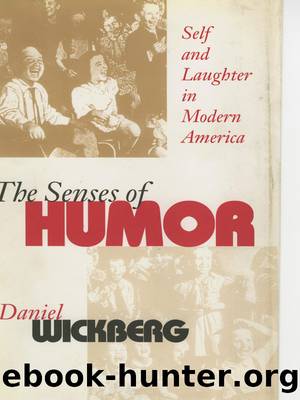The Senses of Humor by Daniel Wickberg

Author:Daniel Wickberg [Wickberg, Daniel]
Language: eng
Format: epub
Tags: Fiction & Literature, Literary Theory & Criticism, Nonfiction, History, Americas, United States
ISBN: 9780801454370
Publisher: Cornell University Press
Published: 2015-06-18T04:00:00+00:00
One can almost hear the rimshot marking the punch line, a convention also derived from vaudeville.
By turning the joke into a dialogue form, Masson and his generation of literary editors removed literary style and manner, narrative voice, and other potentially idiosyncratic elements from their product. The joke was viewed as an objective representation of a moment of dialogue, accessible to all without the intervention of a mediating narrator. The difference between Twainâs construction of humor and Massonâs is thus not merely the difference between an oral and a written form, between how to tell a story and how to write a joke; rather, there is a difference between two models of orality, one narrative and the other theatrical, and their representation in writing. Twainâs most famous stories, like âThe Celebrated Jumping Frog of Calaveras Countyâ and âJim Bakerâs Bluejay,â are, after all, written representations of the oral mode defined in âHow to Tell a Storyâ; they are utterly dependent upon the manner in which they are narrated. What the joke editors of Massonâs generation sought was a form independent of the manner of telling, and they found their model in theatrical dialogue abstracted from its performance. To rely on the idiosyncratic narrative was to personalize the joke, to make it much more difficult to mass-produce, and to create problems in marketing and distributing a nonuniform product. The uniformity of jokes in which there was no narrative intervention, and only the simplest representation of a single incongruous idea, best served the joke market of the later nineteenth and early twentieth centuries. The dialogue form was ideal because it removed the irregularities associated with individual authorship, while providing a condensed narrative through immediately recognizable stock characters and situations.
One of the greatest benefits of the dialogue joke to the joke writers and editors of that era was that it made jokes all that much easier to produce. As Masson put it, âThere are only two ways of writing it. The first way is to get an idea that is worth joking about and then to have two characters make the joke. The second way is to have some character say something, and then get another character to reply in such a way that the joke is made.â In other words, one could approach the joke via the punch line or the straight line, and those were virtually the only ways to approach it. The simplicity of the form allowed for infinite variation within an extremely limited framework. âAs long as you have the architecture of a joke firmly fixed in your mind,â advised Masson, ânewer conditions are always arising to which the old form can be adjusted.â60 This idea of the joke form as a kind of template on which new jokes could be struck would receive more sustained treatment in the hands of the radio gag-writers of the 1930s, who came to depend upon it for their livelihoods. By insisting on the structure of the joke in vaudeville dialogue form, joke writers
Download
This site does not store any files on its server. We only index and link to content provided by other sites. Please contact the content providers to delete copyright contents if any and email us, we'll remove relevant links or contents immediately.
The Power of Myth by Joseph Campbell & Bill Moyers(1000)
Half Moon Bay by Jonathan Kellerman & Jesse Kellerman(951)
A Social History of the Media by Peter Burke & Peter Burke(935)
Inseparable by Emma Donoghue(921)
The Nets of Modernism: Henry James, Virginia Woolf, James Joyce, and Sigmund Freud by Maud Ellmann(833)
The Spike by Mark Humphries;(764)
The Complete Correspondence 1928-1940 by Theodor W. Adorno & Walter Benjamin(746)
A Theory of Narrative Drawing by Simon Grennan(742)
Culture by Terry Eagleton(711)
Ideology by Eagleton Terry;(696)
Bodies from the Library 3 by Tony Medawar(680)
World Philology by(673)
Farnsworth's Classical English Rhetoric by Ward Farnsworth(672)
Game of Thrones and Philosophy by William Irwin(669)
High Albania by M. Edith Durham(654)
Adam Smith by Jonathan Conlin(648)
A Reader’s Companion to J. D. Salinger’s The Catcher in the Rye by Peter Beidler(646)
Comic Genius: Portraits of Funny People by(616)
Monkey King by Wu Cheng'en(609)
